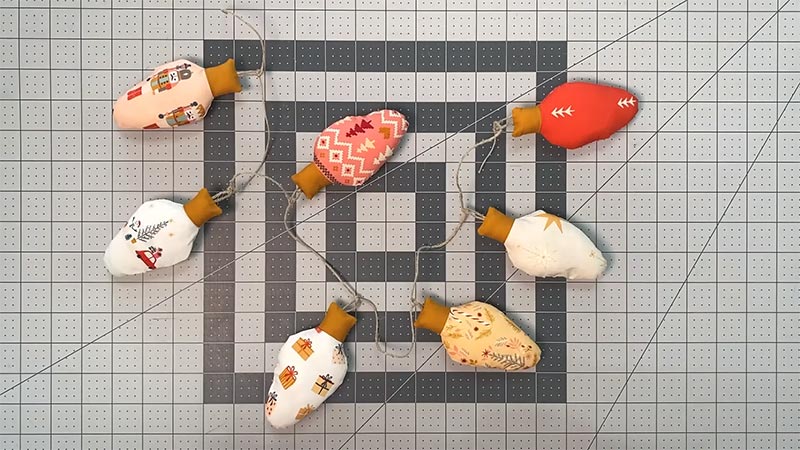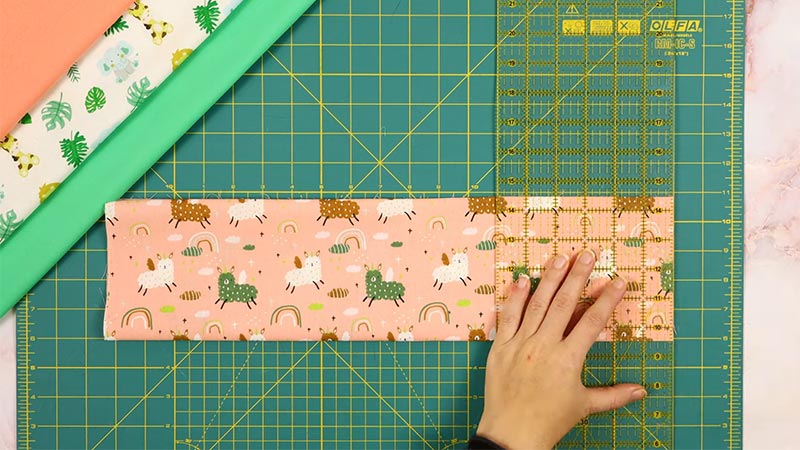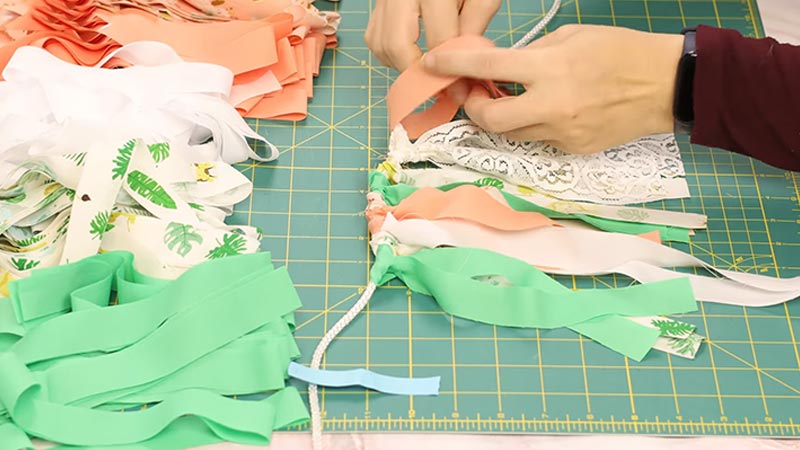Crafting garlands with fabric is a delightful way to infuse your space with charm and personality. These versatile decorations can be tailored to suit any occasion, from festive celebrations to everyday décor.
Whether you’re a seasoned crafter or a beginner, this creative endeavor offers a canvas for self-expression.
With an array of fabrics and techniques at your disposal, you have the power to design garlands that perfectly complement your style and theme.
This guide will walk you through the step-by-step process, unlocking the art of transforming simple fabric into stunning garlands that add a touch of handmade elegance to your surroundings.

How to Make Garland With Fabric?
Creating a fabric garland is a delightful craft project that can add a touch of charm and personality to any space.
Whether you’re decorating for a special occasion or want to add a bit of flair to your home, making a fabric garland is a fun and rewarding endeavor.
Follow these step-by-step instructions to craft your very own beautiful fabric garland.
Materials Needed:
- Assorted fabric scraps or fat quarters
- Scissors
- Twine or ribbon
- Fabric glue or a hot glue gun
- Cutting mat (optional)
- Rotary cutter (optional)
- Cardboard or a fabric stiffener (optional)
- Ruler (optional)
Assemble Your Supplies
Before you begin, it’s essential to have all your materials ready. Select a variety of fabric scraps or fat quarters in colors and patterns that match your desired theme or color scheme.
A well-organized workspace with easy access to scissors, twine ribbon, and glue will help streamline the crafting process.
Prepare the Fabric Strips
To ensure a polished and uniform appearance for your garland, decide on the dimensions of your fabric strips.
You can use a ruler to measure, but a cutting mat and rotary cutter provide precise, straight-edged strips. Common dimensions are 1 to 1.5 inches wide and 8 to 12 inches long.
Choose Your Garland Pattern
Consider the overall look you want to achieve with your fabric garland.
You can create a random mix of colors and patterns for a bohemian feel or choose a specific sequence of fabrics for a more organized and cohesive look. This step allows you to customize your garland to your taste and style.
Fold and Cut the Fabric Strips
With your fabric strips cut to size, it’s time to add a decorative touch. Fold each strip in half lengthwise, ensuring that the printed or colored side is on the inside.
Carefully cut a V-shape at the folded end, creating a pointed tip. This step gives your fabric pieces a unique and appealing appearance.
Attach Fabric Pieces to Twine or Ribbon
Measure and cut the twine or ribbon to your desired length, leaving a little extra at each end for tying or hanging.
To attach the fabric pieces, apply a small amount of glue along each strip’s folded end and press it onto the twine or ribbon. Leave a few inches of space between each fabric piece to maintain balance in your garland.
Continue Adding Fabric Pieces
Keep adding fabric pieces along the length of the twine or ribbon, following your chosen pattern or arrangement.
Whether you’re going for a symmetrical look or a more random distribution, ensure each fabric strip adheres securely to the twine or ribbon. Gently press down on each piece to ensure a strong bond.
Add Extra Embellishments
Consider incorporating embellishments such as small fabric bows, beads, or sequins for an extra touch of creativity and personalization.
Use fabric glue to attach these elements to your fabric garland. This step allows you to make your garland even more unique and tailored to your style.
Set and Hang
When you use fabric glue, allow your fabric garland to dry completely before hanging it. This may take a few hours to ensure a strong bond.
When you use a hot glue gun, your garland should be ready to hang immediately. Find the perfect spot to display your handmade fabric garland, whether it’s for a special event or as a charming addition to your home decor.
What Kind of Fabric Do You Need to Make Garland?

You can use a variety of fabrics to make a garland, depending on the look and feel you want to achieve.
Common fabric choices for making garlands include:
Cotton
Cotton fabric is popular for garlands due to its wide availability and versatility. It comes in an extensive range of colors and patterns, making it easy to find options that match your desired theme or decor. Cotton is easy to work with, making it an excellent choice for both beginners and experienced crafters.
Linen
Linen fabric offers a natural, textured appearance that lends itself well to garlands with an organic or rustic aesthetic.
Its earthy tones and breathable quality make it a great choice for outdoor events or gatherings with a nature-inspired theme. Linen garlands exude a timeless elegance that complements various decor styles.
Satin
Satin fabric adds a touch of luxury and opulence to garlands, making it perfect for special occasions like weddings, anniversaries, or formal gatherings.
The smooth, glossy surface of satin creates a sophisticated look, and it drapes beautifully, allowing for graceful swags and loops in your garland design.
Lace
Lace fabric is known for its delicate and intricate patterns, making it an excellent choice for creating romantic and vintage-inspired garlands.
Whether used alone or layered with other fabrics, lace adds a touch of femininity and sophistication to any decor. It’s popular for bridal showers, weddings, and other romantic occasions.
Tulle
Tulle fabric is lightweight, airy, and often associated with creating a soft, ethereal look. It’s a popular choice for garlands at baby showers, gender reveal parties and bridal events.
Tulle comes in various colors, allowing you to achieve a dreamy, whimsical effect that complements various themes.
Felt
Felt fabric is a sturdy and versatile material for crafting garlands. Its thickness and texture allow for easy cutting and shaping, making it ideal for creating bold, solid shapes.
Felt garlands are often used for playful and festive decor and are a favorite for holiday-themed projects.
Burlap
Burlap fabric is characterized by its rustic and textured appearance, making it a popular choice for garlands with a farmhouse or country-style theme.
Its earthy tones and coarse texture add a charming and down-to-earth quality to the decor. Burlap garlands are often used for events with a cozy, homespun feel.
Sewing Scraps
Using leftover fabric scraps from previous projects is a sustainable and creative way to make a garland. It gives your garland a unique and eclectic look, showcasing your resourcefulness and commitment to reducing waste.
Different Methods For Making a Garland With Fabric

There are various methods for making a garland with fabric. Here are three different techniques you can try:
Sewn Fabric Bunting Garland
Materials Needed:
- Fabric scraps or fat quarters
- Sewing machine and thread
- Bias tape or ribbon
Steps:
- Cut fabric triangles: Determine the size of your triangles and cut out the fabric pieces. Each triangle should be double-layered (with a front and back).
- Sew triangles: Place two triangles together with the right sides facing in. Sew along the two longer sides, leaving the top open. Repeat for all triangles.
- Turn and press: Turn the triangles on the right side out and press them flat. Trim any excess fabric if needed.
- Attach to bias tape or ribbon: Position the triangles along the bias tape or ribbon, leaving a gap between each one. Sew along the top edge to secure them in place.
Rolled Fabric Rosette Garland
Materials Needed:
- Fabric strips
- Hot glue gun and glue sticks
- Twine or ribbon
Steps:
- Create fabric rosettes: Take a fabric strip and fold one end. Begin rolling it tightly to form a rosette, securing it with hot glue along the way. Repeat for as many rosettes as you need.
- Attach rosettes to twine or ribbon: Apply hot glue to the back of each rosette and press it onto the twine or ribbon, evenly spacing them out.
10 Famous Designs of Garland With Fabric
Fabric garlands have long been a beloved choice for adorning spaces with charm and elegance. From classic designs to innovative creations.
Here are ten famous designs of fabric garlands that have captured hearts and inspired countless crafters:
1. Vintage Lace Garland
Vintage lace garlands exude timeless romance and elegance. Delicate lace fabric, often sourced from heirloom pieces or vintage shops, is carefully arranged and strung, creating a soft, ethereal ambiance.
These garlands are highly sought after for weddings, tea parties, and events with a touch of vintage charm.
2. Rustic Burlap Bunting
The rustic burlap bunting exudes a cozy countryside feel. Each triangular pennant, fashioned from sturdy burlap, exudes a warm, earthy quality.
These garlands are popular for barn weddings, outdoor gatherings, and events with a rustic theme, adding a touch of natural charm.
3. Bohemian Tassel Garland
Bohemian tassel garlands burst with vibrant colors and free-spirited energy. Strips of colorful fabric are artfully tied to twine or ribbon, creating playful tassels that sway gracefully.
These garlands are ideal for boho-inspired parties, festivals, or any occasion with a desired lively, carefree atmosphere.
4. Rosette Flower Garland
Rosette flower garlands are a testament to meticulous craftsmanship. Each rosette, meticulously rolled and secured, mimics the delicate beauty of blossoms.
When strung together, they create a garland that radiates whimsical charm. These garlands are perfect for weddings, baby showers, or events where a touch of floral elegance is desired.
5. Ruffled Fabric Garland
Ruffled fabric garlands exude a timeless and refined elegance. Layers of fabric are carefully gathered and sewn, creating a cascade of soft, flowing ruffles.
These garlands add a touch of sophistication to weddings, anniversaries, or any event that calls for a touch of understated glamour.
6. Ombre Fabric Garland
Ombre fabric garlands showcase a stunning gradient of colors, creating a visual feast for the eyes.
The careful arrangement of fabrics in varying shades produces a captivating ombre effect. These garlands are a modern and stylish choice for parties, showers, or events with a desired touch of contemporary flair.
7. Patchwork Quilt Garland
Patchwork quilt garlands pay homage to the comforts of home and the art of quilting. Small fabric squares, often with diverse patterns and colors, are lovingly sewn together, creating a charming patchwork effect. These garlands are perfect for gatherings celebrating the warmth of togetherness and tradition.
8. Nautical Knot Garland
Nautical knot garlands bring a touch of maritime charm to any setting. Rope or twine is adorned with carefully crafted fabric knots, evoking the spirit of the sea.
These garlands are a wonderful choice for beach weddings, coastal events, or gatherings where a touch of seaside ambiance is desired.
9. Shabby Chic Rag Garland
Shabby chic rag garlands exude a playful and worn-in charm. Fabric strips, ribbons, and lace are artfully tied together, creating a whimsical and eclectic look.
These garlands are perfect for events that embrace a casually elegant and vintage-inspired aesthetic.
10. Floral Fabric Garland
Floral fabric garlands bring the beauty of a garden indoors. Fabric blossoms, petals, and leaves are meticulously crafted and assembled, creating a garland that mimics the vibrancy of nature.
These garlands are ideal for weddings, garden parties, or events with a desired touch of natural beauty.
Maintenance Tips
Maintaining fabric garlands ensures they stay looking beautiful and vibrant over time.
Here are some maintenance tips to help you preserve your fabric garland:
Regular Dusting
Dust and dirt can accumulate on fabric garlands, especially if they’re hanging in open areas. Gently dust your garland with a soft brush or a lint roller to keep it clean and fresh.
Spot Cleaning
When you notice any stains or spots on your fabric garland, address them promptly. Use a damp cloth or sponge and a mild detergent to gently spot-clean the affected areas.
Be cautious not to soak the fabric excessively, as it may affect any glue used in the assembly.
Storage
When your garland is not in use, store it in a cool, dry place away from direct sunlight. To prevent tangling or damage, coil or fold it neatly and place it in a container or a sealed plastic bag.
Avoid Moisture
Fabric garlands are susceptible to moisture damage. Keep them away from humid environments, as excess moisture can lead to mold or mildew growth on the fabric.
Gentle Handling
Handle your fabric garland carefully, especially when washing it or putting it up. Pulling or tugging too hard can damage the fabric or the string holding it together.
Replace Worn Parts
Over time, the fabric may wear, and the glue or attachment points may weaken. If you notice any loose fabric pieces or fraying edges, repair them promptly. You can use fabric glue or a hot glue gun to reattach fabric pieces as needed.
Rotate Usage
When you have multiple fabric garlands, consider rotating them for different seasons or occasions. This helps distribute wear and tear evenly among your garlands and prevents overuse of a single piece.
Inspect for Pests
Fabric garlands stored for extended periods may attract pests like moths. Before using them again, inspect the garland for any signs of damage or pests and take appropriate measures to address any issues.
Hang Properly
When hanging your garland, ensure it’s properly supported and not exposed to strong winds or harsh weather conditions if used outdoors. Using appropriate hooks, strings, or clips can help maintain its integrity.
FAQs
Can I use different types of fabric for my garland?
Absolutely! You can use a variety of fabrics, including cotton, linen, satin, or even lace, to create a diverse and textured look for your garland.
Do I need to sew the fabric pieces together?
No, sewing is not necessary. You can use fabric glue or a hot glue gun to attach the fabric pieces to the twine or ribbon.
How do I clean a fabric garland if it gets dirty?
Gently spot-clean any stains with a mild detergent and water. Avoid soaking the fabric, as it may affect the glue.
Can I make a garland with specific seasonal themes?
Absolutely! You can select fabrics and colors corresponding to different seasons, making it a versatile decoration for various occasions.
Can I add lights to my fabric garland for a festive touch?
Incorporating small LED lights can add a beautiful and whimsical element to your garland fabric. Just make sure to secure them safely to avoid any fire hazards.
Wrap Up
In crafting a fabric garland, creativity knows no bounds. Each step, from selecting fabrics to assembling, is an opportunity to infuse personal style. The choice of fabric—be it elegant satin or rustic burlap—sets the tone.
Folding and cutting, a delicate touch transforms mere cloth into artful adornments. Thoughtful arrangement yields a visual symphony, whether for festivities or daily décor.
Optional embellishments add a bespoke touch, while storage and gentle handling ensure longevity.
This craft is more than a project; it’s an expression of individuality, a testament to the beauty that can emerge from simple, everyday materials.
Leave a Reply